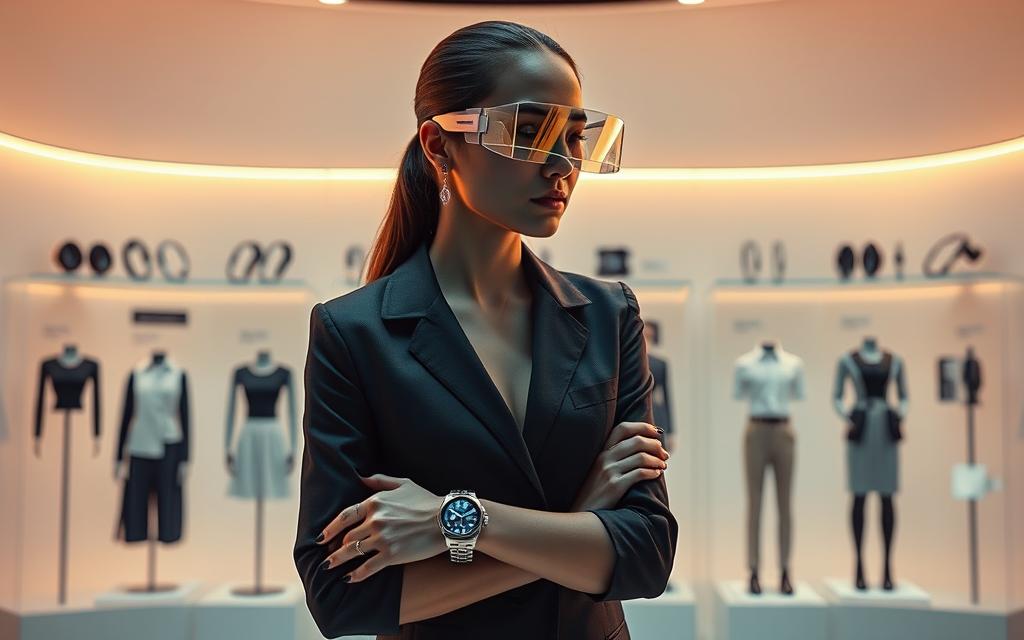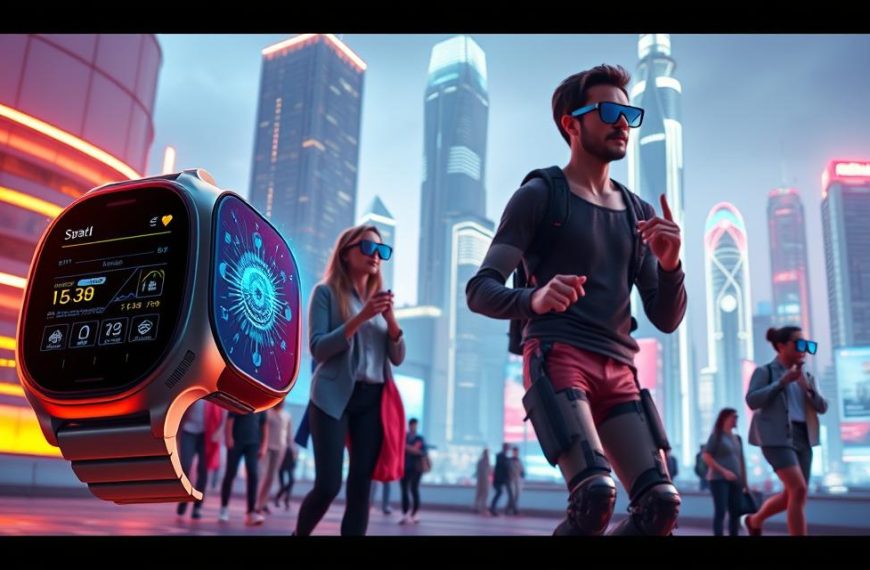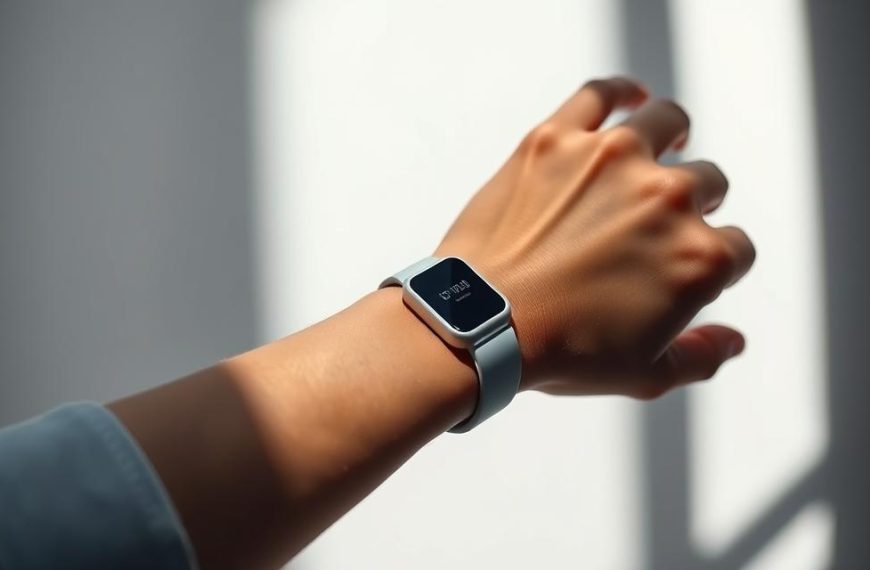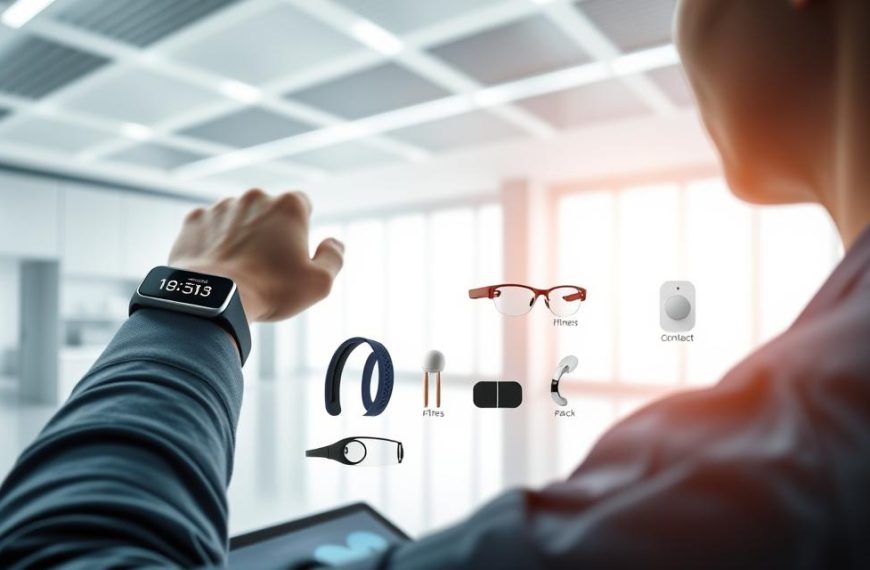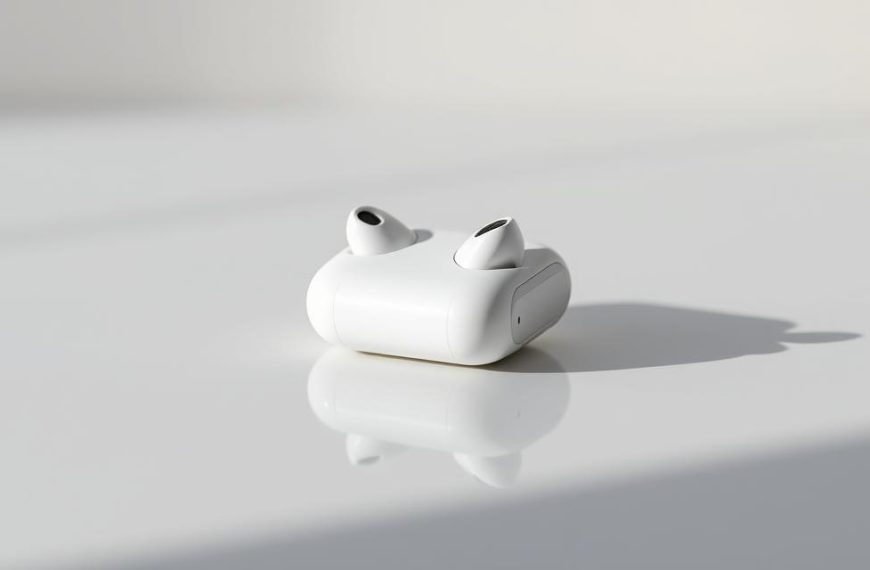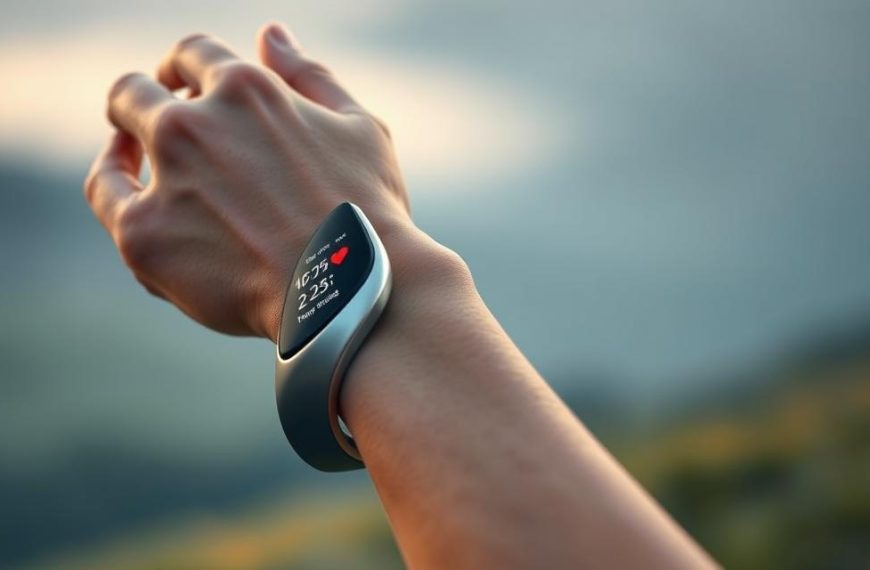The future of wearable technology is here, and it’s transforming industries like never before. From healthcare to fitness and workplace productivity, these devices are reshaping how we live and work. By 2025, innovations in AI integration, next-gen materials, and advanced biosensors are setting new standards for functionality and design.
Market projections indicate explosive growth, with the sector expected to reach $151.8 billion by 2029. Key applications include AR glasses, eco-friendly designs, and real-time health monitoring. These trends are not just about convenience—they’re about improving lives and driving efficiency.
This article dives into actionable insights for tech adopters and healthcare professionals. Discover how these advancements can benefit you and stay ahead in a rapidly evolving landscape.
Introduction to Wearable Technology in 2025
The wearable technology market is booming, driven by consumer demand for health and wellness solutions. By 2025, these devices will play a pivotal role in transforming industries, from healthcare to industrial safety.
Gen Z and millennials are leading the charge, adopting wearable devices at an unprecedented rate. This demographic values convenience, personalization, and real-time data, pushing manufacturers to innovate.
What started as basic fitness trackers has evolved into AI-powered diagnostic tools. These innovations now monitor chronic conditions like diabetes and predict health risks with remarkable accuracy. Forbes Council highlights the integration of Electronic Health Records (EHR) and predictive analytics as a game-changer.
Beyond healthcare, wearable devices are enhancing workplace safety. Industrial workers use them to monitor vital signs and environmental hazards, reducing accidents and improving efficiency.
Sustainability is also a key focus. Manufacturers are adopting eco-friendly materials and modular designs to meet consumer expectations for environmentally conscious products.
| Year | Market Value (Billion USD) | Growth Rate (CAGR) |
|---|---|---|
| 2023 | 35.6 | 27.5% |
| 2029 | 151.8 | 27.5% |
As the market continues to expand, technology will become more integrated into daily life. Wearable devices are no longer just gadgets—they’re essential tools for improving health, safety, and productivity.
Advanced Health Monitoring Devices
Modern sensors in wearable devices provide real-time insights into vital health metrics. These innovations are transforming how we monitor and manage wellness, offering precision and convenience like never before.
Fitness Trackers and Smartwatches
Next-gen fitness trackers and smartwatches are packed with advanced features. The Apple Watch Series 8 and Garmin 965 include FDA-cleared ECG capabilities, enabling users to monitor their heart rate and detect irregularities. Xiaomi Mi Band 9 measures SpO2 and stress levels using PPG sensors, making it a versatile device for daily use.
Continuous Glucose Monitoring
Continuous glucose monitors (CGMs) like Medtronic’s systems have shown remarkable results. Clinical trials report a 35% reduction in hypoglycemia events, helping users maintain optimal blood sugar levels. These devices are particularly beneficial for individuals managing diabetes.
Blood Pressure Trackers
FDA-approved blood pressure trackers are becoming more accessible. The Omron HeartGuide and Samsung Galaxy Watch offer accurate readings, empowering users to monitor their blood pressure in real-time. Here’s a comparison of these devices:
| Device | Features | Accuracy |
|---|---|---|
| Omron HeartGuide | Wearable cuff, app integration | Clinically validated |
| Samsung Galaxy Watch | ECG, SpO2 monitoring | FDA-cleared |
Wearable Biosensors
Wearable biosensors are pushing the boundaries of health monitoring. Microfluidic patches enable non-invasive biomarker analysis, while neural interfaces like the Empatica Embrace3 monitor epilepsy. These sensors are also used in post-surgical recovery and sepsis detection, providing critical data for healthcare professionals.
Fitness and Lifestyle Wearables
From stress tracking to hydration reminders, these devices are reshaping personal health routines. Wearables now go beyond basic fitness metrics, offering tools for comprehensive wellness management. Whether you’re an athlete or a busy professional, these innovations cater to diverse needs.
Stress Management Tools
Modern wearables like WHOOP 5.0 measure heart rate variability (HRV) and skin temperature to assess recovery and stress levels. Forbes highlights cortisol-tracking biosensors that help users manage stress effectively. These tools provide actionable insights, enabling better mental health management.
Personalized Fitness Coaching
AI-powered platforms like Tempo Move and Fitbit Premium use motion sensors to deliver tailored workout plans. According to ACSM, 73% of trainers now rely on wearable data for client programming. This personalized approach ensures optimal activity and performance tracking.
Hydration Reminders
IoT-enabled water bottles sync with wearables from Garmin and Huawei to monitor hydration levels. Lululemon’s “Lemonade” fabric, embedded with sweat sensors, also tracks fluid loss during workouts. These innovations ensure users stay hydrated and maintain peak performance.
- WHOOP’s recovery metrics are trusted by NFL and NBA athletes.
- AI coaching platforms adapt to individual fitness goals.
- Hydration tracking tools sync seamlessly with wearables for real-time updates.
By integrating these features, wearables are transforming how we approach sleep, activity, and overall wellness. They’re not just gadgets—they’re essential tools for a healthier lifestyle.
Smart Glasses and Augmented Reality (AR)
Smart glasses are revolutionizing how we interact with the world, blending digital and physical realities seamlessly. These devices are no longer limited to niche applications—they’re transforming industries like healthcare, education, and gaming. With advancements in augmented reality, users can now experience immersive digital overlays in real-time.
Applications in Healthcare
In healthcare, smart glasses are enabling groundbreaking collaboration and precision. Platforms like Proximie allow surgeons to receive remote expert guidance during procedures. AI-powered glasses can recognize medical instruments and patient data, overlaying critical information directly into the surgeon’s field of view. This innovation is reducing errors and improving outcomes.
Enhancing Productivity and Gaming
For industries, smart glasses are boosting efficiency. Lockheed Martin uses AR-assisted workflows for aircraft maintenance, streamlining complex tasks. In gaming, augmented reality integrations with Unity and Unreal Engine are creating mixed-reality experiences. Devices like Meta Orion, with 8K resolution and holographic displays, are setting new standards for immersion.
Educational and Training Uses
Education is also benefiting from AR glasses. Partnerships with platforms like Coursera and Khan Academy are delivering interactive learning content. Enterprises are leveraging devices like Microsoft HoloLens 3 and Magic Leap 2 for training simulations, offering hands-on experiences without real-world risks. These tools are shaping the future of education and professional development.
As smart glasses continue to evolve, their potential across various sectors is limitless. For more insights, explore the future of wearable technology.
Wearables for the Workplace
Workplace environments are evolving with the integration of cutting-edge wearable tech. These devices are enhancing safety, improving communication, and boosting efficiency across industries. From manufacturing to energy, wearables are becoming essential tools for modern businesses.
Improving Safety and Communication
Wearables are transforming workplace safety. 3M’s AR safety glasses have reduced manufacturing errors by 41%, while Amazon’s AI-powered safety vests provide proximity alerts to prevent accidents. RealWear HMT-2 headsets are used in Shell oil rig inspections, offering hands-free communication in hazardous environments.
Enhancing Collaboration and Efficiency
Collaboration is also getting a boost. Dell’s smart ring uses gesture recognition to control presentations, streamlining meetings. NTT Data’s EEG headbands optimize operator focus in control rooms, ensuring peak performance. These innovations are redefining how teams work together.
Examples of Workplace Wearables
Here are some standout examples of workplace wearables:
- Exoskeleton suits like the Sarcos Guardian reduce warehouse injuries by supporting heavy lifting.
- RealWear HMT-2 headsets enable remote inspections in challenging environments.
- Pay-per-use models for industrial IoT wearables are making advanced tech more accessible.
| Device | Application | Impact |
|---|---|---|
| 3M AR Glasses | Manufacturing | Reduces errors by 41% |
| Dell Smart Ring | Presentations | Gesture-controlled |
| Amazon Safety Vest | Warehousing | Proximity alerts |
These devices are not just tools—they’re reshaping workplace design and operations. By integrating wearables, businesses can improve safety, streamline workflows, and provide valuable feedback to employees.
Sustainability and Customization in Wearables
Customization and sustainability are now key priorities in wearables. Consumers demand eco-friendly products that align with their values, while personalization ensures devices meet individual needs. These trends are driving innovation in both materials and design.
Eco-Friendly Materials and Manufacturing
Brands are adopting sustainable practices to reduce environmental impact. Adidas’ Futurecraft.Loop shoes, made from 100% recyclable TPU, showcase how circular economy models can work. Apple’s watch bands, crafted from recycled materials, are another example of eco-conscious design.
Innovative materials like biodegradable PCBs using mushroom mycelium substrates are gaining traction. Garmin’s solar-powered Instinct 2X, with a 10-year battery life, highlights the potential of renewable energy in wearables. These advancements reflect a commitment to sustainability.
Modular Design and Personalization
Modular design allows users to upgrade components, extending product lifespans. Fairphone’s modular smartwatch enables easy repairs and part replacements, reducing electronic waste. Google’s Project Jacquard 2.0 introduces customizable fabric interfaces, blending style with functionality.
EU regulations are also pushing for right-to-repair wearables, encouraging manufacturers to adopt modular designs. This shift not only supports sustainability but also empowers consumers to personalize their devices.
What Are the Latest Advancements in Wearable Technology?
Wearable devices are evolving rapidly, thanks to groundbreaking AI, advanced materials, and state-of-the-art sensors. These innovations are not just enhancing functionality but also redefining how we interact with technology daily.
Integration of AI and Machine Learning
Artificial intelligence is transforming wearables into intelligent assistants. Devices now use AI to analyze health data, predict risks, and offer personalized recommendations. For example, MIT’s subdermal sensors can detect cytokines three days before symptom onset, enabling early intervention.
DARPA-funded epidermal electronics are another breakthrough. These devices monitor soldier health in real-time, showcasing the potential of AI in critical applications. Such technologies are setting new standards for predictive healthcare.
Next-Gen Materials and Form Factors
Materials like graphene are revolutionizing wearable design. Graphene-based e-tattoos, for instance, monitor UV exposure and ozone levels with unmatched precision. These innovations are lightweight, durable, and eco-friendly.
Siemens’ piezoelectric shoe insoles generate 5W of energy from walking, highlighting the potential of self-powered wearables. UCLA’s quantum dot tattoos are another example, offering vaccine tracking capabilities through innovative material science.
State-of-the-Art Sensors
Advanced sensors are pushing the boundaries of wearable functionality. Stanford’s sweat-powered biosensor patch aids in cystic fibrosis management, while neural interfaces raise ethical questions about data privacy.
These technologies are not just about convenience—they’re about improving lives. From health monitoring to energy generation, the possibilities are endless.
Conclusion
Innovations in wearable tech are shaping the future of healthcare and daily life. Key trends like hyper-personalization through AI and breakthroughs in material science are driving this evolution. By 2026, over 15 new medical wearables are expected to gain FDA approval, further integrating these devices into healthcare systems.
As wearables become more cloud-connected, addressing cybersecurity is crucial to protect user data. Emerging markets, such as the $4.8 billion smart clothing sector, highlight the growing demand for innovative solutions.
Enterprises that adopt these technologies gain a competitive edge, improving efficiency and enhancing user experiences. The future of wearables is not just about convenience—it’s about transforming industries and improving quality of life.

